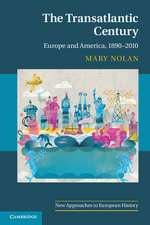Cultural Hierarchy in Sixteenth-Century Europe: The Ottomans and Mexicans
Autor Carina L. Johnsonen Limba Engleză Paperback – 5 mar 2014
| Toate formatele și edițiile | Preț | Express |
|---|---|---|
| Paperback (1) | 339.96 lei 6-8 săpt. | |
| Cambridge University Press – 5 mar 2014 | 339.96 lei 6-8 săpt. | |
| Hardback (1) | 697.62 lei 6-8 săpt. | |
| Cambridge University Press – 29 sep 2011 | 697.62 lei 6-8 săpt. |
Preț: 339.96 lei
Nou
Puncte Express: 510
Preț estimativ în valută:
65.06€ • 67.67$ • 53.71£
65.06€ • 67.67$ • 53.71£
Carte tipărită la comandă
Livrare economică 12-26 aprilie
Preluare comenzi: 021 569.72.76
Specificații
ISBN-13: 9781107638983
ISBN-10: 1107638984
Pagini: 340
Ilustrații: 32 b/w illus.
Dimensiuni: 152 x 229 x 19 mm
Greutate: 0.5 kg
Editura: Cambridge University Press
Colecția Cambridge University Press
Locul publicării:New York, United States
ISBN-10: 1107638984
Pagini: 340
Ilustrații: 32 b/w illus.
Dimensiuni: 152 x 229 x 19 mm
Greutate: 0.5 kg
Editura: Cambridge University Press
Colecția Cambridge University Press
Locul publicării:New York, United States
Cuprins
Part I. Categories of Inclusion: 1. Cultures and religions; 2. Iberia after Convivencia; 3. Aztec regalia and the reformation of treasure; Part II. Experiments of Inclusion: 4. Boundaries and cultures of diplomacy in central Europe; 5. Imperial authority in an era of confessions; 6. Collecting idolatry and the emergence of the exotic; Part III. Conclusion: 7. Categorical denials.
Recenzii
'In this original, imaginative, and solidly researched book, Johnson draws on an impressive array of textual and visual evidence to answer the following intriguing questions: how did the Habsburg realms receive and process information on Meso-Americans of the New World and on Turks of the Ottoman Empire, and in what ways were the actual persons, images, and cultural artifacts of these non-European peoples and their material cultures represented and used during the sixteenth century? The result is an impeccable work of scholarship with complex and subtle arguments.' R. Po-chia Hsia, Pennsylvania State University
'In this fascinating study that assesses the sophisticated information networks that brought news of the Mexican and Ottoman empires to the Habsburg realms, Carina Johnson offers new insights into the creation of cultural hierarchies in sixteenth-century Europe. From the collecting habits of European elites to the new attitudes that developed toward the spoils of the New World in the wake of the Protestant and Catholic reformations, Johnson explores a remarkably wide range of sources as she provides us with a series of challenging reflections on the formation of cultural boundaries in this critical period.' Howard Louthan, University of Florida
'In this innovative rethinking of the relationship between the Reformation and early modern cultural exchange, Carina Johnson vividly demonstrates how religious conflict altered European perceptions of not only Christian objects and symbols, but also of Ottomans, North Africans, and Tlaxcalans and their material cultures. Using an impressive array of archival materials, she shows how the Habsburg monarchy formulated a cultural hierarchy that progressively exoticized and demonized non-Europeans and heterodox Christians as a means to legitimate its authority in an increasingly diverse and conflicted world.' Allyson M. Poska, University of Mary Washington
'In this fascinating study that assesses the sophisticated information networks that brought news of the Mexican and Ottoman empires to the Habsburg realms, Carina Johnson offers new insights into the creation of cultural hierarchies in sixteenth-century Europe. From the collecting habits of European elites to the new attitudes that developed toward the spoils of the New World in the wake of the Protestant and Catholic reformations, Johnson explores a remarkably wide range of sources as she provides us with a series of challenging reflections on the formation of cultural boundaries in this critical period.' Howard Louthan, University of Florida
'In this innovative rethinking of the relationship between the Reformation and early modern cultural exchange, Carina Johnson vividly demonstrates how religious conflict altered European perceptions of not only Christian objects and symbols, but also of Ottomans, North Africans, and Tlaxcalans and their material cultures. Using an impressive array of archival materials, she shows how the Habsburg monarchy formulated a cultural hierarchy that progressively exoticized and demonized non-Europeans and heterodox Christians as a means to legitimate its authority in an increasingly diverse and conflicted world.' Allyson M. Poska, University of Mary Washington
Notă biografică
Descriere
Concentrating on the Habsburg Empire, this book examines the creation of cultural hierarchy in sixteenth-century Europe.














